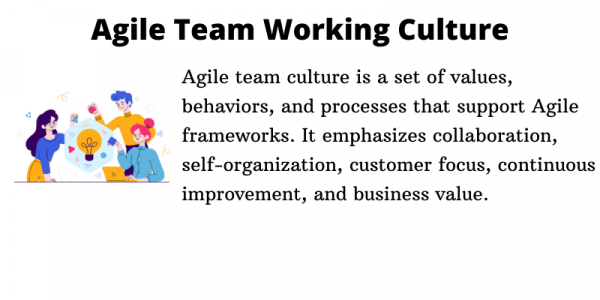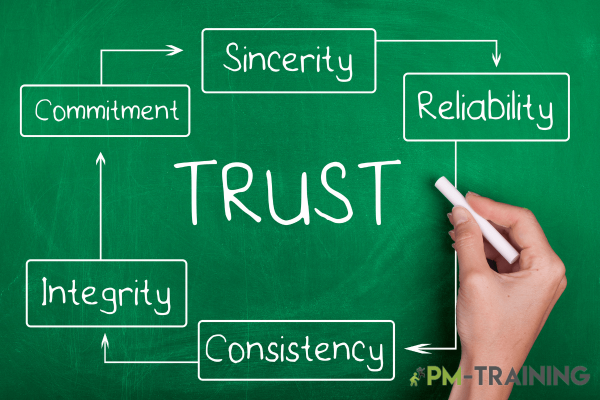Like most people, you probably think of agile as a software development methodology. And you would be right – it is that! But agile is also so much more. Agile is a way of life, a mindset, and a culture.
In this blog post, we will look at what is the agile team working culture. We’ll explore the different agile team requirements and discuss the benefits of working in an agile environment.
What is Agile Team Culture?
Agile team culture is a set of values, behaviors, and processes that support Agile frameworks. It emphasizes collaboration, self-organization, customer focus, continuous improvement, and business value. Agile team culture values people over process, and Agile teams work collaboratively to deliver business value incrementally.
Moreover, the Agile team culture is customer-focused and supports the delivery of business value through the early and continuous delivery of working software. Agile teams work closely with customers to ensure that the software they deliver meets the customer’s needs.
Agile teams continuously improve their process and practices and learn from their mistakes. They are self-organizing and have the autonomy to decide how best to provide business value. Agile team culture

Principles of Agile Team Working Culture
Building an effective agile team requires more than just putting the right people together. It also requires creating a culture that supports and encourages collaboration, communication, and continuous learning.
Four key principles help to shape an agile team culture:

Trust and transparency
Trust is necessary for team members to be willing to share ideas and work together effectively. It is the foundation of any good team, and it starts with each member being able to trust the other team members. Trust also allows team members to feel comfortable taking risks, which is essential for innovation.
For team members to trust each other, they need to feel safe sharing their ideas and being open about their thoughts and feelings. When team members feel like they can trust each other, they are more likely to be open and honest, leading to better communication and collaboration.
Transparency is just as important as trust when creating a successful team. With transparency, it is easier for team members to hold each other accountable or identify areas where improvements need to be made.
Transparency also allows team members to see where they need to step up and take on more responsibility. By being transparent with each other, teams can create an environment of mutual respect and understanding.
By fostering a culture of trust and transparency, agile teams can create an environment where everyone can do their best work.

Accountability
Agile teams are built on a foundation of accountability. Each team member is responsible for their work and is accountable to the team as a whole. This accountability culture fosters trust and respect, where team members feel confident that they can rely on each other to get the job done.
It also promotes creative problem-solving and open communication, as team members feel empowered to speak up and offer new ideas. In an agile team culture, everyone has a shared sense of ownership and responsibility for the team’s success.
This sense of ownership fosters a greater commitment to the team’s goals and a willingness to go the extra mile to achieve them. As a result, agile teams are highly effective and can achieve great things together.

Customer focus
Agile team culture is based on the principle of customer focus. It means that the team puts the customer’s needs first and works to deliver the best possible product or service. To do this, the team must clearly understand what the customer wants and needs.
It requires close communication and collaboration with the customer throughout the development process. Additionally, the team must be willing to make changes based on feedback from the customer. By putting the customer first, an agile team can ensure that they are always meeting their needs.

Continuous improvement
Agile team culture is one that is founded on the principle of continuous improvement. That is, teams should always look for ways to improve their processes and methods to achieve better results. It is essential that teams not only identify areas for improvement but also take action to implement changes.
You can do this through various means, such as retrospectives, process audits, and root cause analysis. Only by constantly striving to improve will teams achieve their true potential.
When everyone on the team embraces these principles, it creates an environment where creative problem-solving can thrive, and team members can feel confident taking risks. As a result, the team is better equipped to respond quickly to changes and adapt to new challenges.
Ultimately, an agile team culture helps to foster a spirit of innovation and creativity that is essential for any organization that wants to stay ahead of the curve.

How to Build Agile Team Culture?
As part of agile documentation, one of the project manager’s most important tasks is to build an agile team culture. To make an agile team culture, you need to create an environment where team members feel comfortable sharing their ideas and suggestions. You must also encourage collaboration by breaking down silos and encouraging cross-functional communication.
In addition, you need to foster a sense of ownership and responsibility among team members by giving them the autonomy to make decisions and take action. By creating an agile team culture, you can help your team be more responsive to changes and better able to achieve success. Noting how you create your agile team requirements can help with your agile documentation.

Balanced vs. Unbalanced Team Culture
A balanced team culture is essential for high-performing teams, as it fosters Trust, cooperation, and a sense of ownership. It is one in which team members feel equally invested in the team’s success and failure. Each team member feels that their contributions are valued and that they are working towards a common goal.
In an unbalanced team culture, there may be a lack of trust or respect between team members or a sense of competition rather than cooperation. It can lead to a feeling of being “on your own” within the team, which can be demotivating and lead to poor performance. Unbalanced team cultures can lead to conflict, low morale, and poor performance.
Agile team culture is based on key principles, including customer focus, continuous improvement, and balanced vs. unbalanced team cultures. When everyone on the team embraces these principles, it creates an environment where creative problem-solving can thrive, and team members can feel confident taking risks. As a result, the team is better equipped to respond quickly to changes and adapt to new challenges.
Ultimately, an agile team culture helps to foster a spirit of innovation and creativity that is essential for any organization that wants to stay ahead of the curve. Project managers must build an agile team culture to help their teams be more responsive to changes and achieve success.
